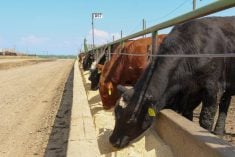Western Canadian feeder cattle prices have been trading near historical highs throughout the summer and early fall period.
At the time of writing this article, larger-frame Angus steers off grass averaging 950 lbs. were trading around $320/cwt in central Alberta. Steers averaging 500 lbs. were quoted between $450/cwt and $500/cwt, depending on weaning stage and quality features.
I’ve received many calls over the past few months regarding the projected calf numbers for the next couple of years. Cow-calf producers are wondering if prices will remain at the current levels for the next year. In this article, I’ll review a few observations of feeder cattle fundamentals and look at what feeder cattle futures are telling us.
Read Also

Gentle treatments for pain in the neck
Heading toward year-end, people unknowingly tense up against the cold and busyness, causing neck pain that can often be treated with appropriate support and gentle mobility, athletic therapist Kathlyn Hossack says.
Statistics Canada’s July 1 livestock inventory report showed feeder cattle supplies outside finishing feedlots in Western Canada were marginally lower than year-ago levels.
In Western Canada, total yearlings on cow-calf operations and backgrounding lots as of July 1, 2024, were 1.109 million head, up 15,000 head from last year.
Total calves were 2.82 million head, down 74,300 head from July 1, 2023. Total feeder cattle supplies outside finishing feedlots in Western Canada on July 1, 2024 were 3.929 million head, down 1.5 per cent or 59,200 head from the July 1, 2023 number of 3.988 million head.
Western Canadian cow-calf producers continued to contract the herd in 2024. According to StatCan’s July 1 data, western Canadian beef cow numbers as of July 1 totaled 3.107 million head, down 2.5 per cent, or 77,900 head, from last year.
Heifers for beef cow replacements were 526,200, up only 3,100 head from 12 months earlier. Due to U.S. Department of Agriculture budget cuts, there was no U.S. July 1 cattle inventory report this year. While the cattle producer has been contracting the herd this year, there are signs that the industry is in a transition.
Table: CME live and feeder cattle futures on Sept. 26, 2024.
| Live cattle | |
| December 2024 | $184 |
| April 2025 | $185 |
| August 2025 | $176 |
| December 2025 | $178 |
| Feeder cattle | |
| October 2024 | $245 |
| March 2025 | $235 |
| August 2025 | $247 |
There are two main points we can observe from the price structure of feeder cattle futures. At the time of writing this article, October 2024 feeder cattle futures were trading at $245 while the March 2025 contract was near $235. It’s interesting to note the August 2025 contract was hovering around $247. The spreads between the futures contracts tell an interesting story.
First, the inverse in the feeder cattle futures between October 2024 and March 2025 mirrors the inverse in the April 2025 and August 2025 live cattle futures. Remember, the feeder cattle futures are the live cattle futures five months forward. Cow-calf producers are encouraged to sell their calves sooner, rather than later. Expectations are for a weaker fed cattle market during the summer of 2025.
Secondly, August 2025 feeder cattle is trading at a $12 premium over the March 2025 contract. This is considered the herd expansion premium. Notice the carry in the feeder market between March and August 2025 contracts is not mirrored in the August 2025 and December 2025 live cattle futures. History tells us the U.S. cow-calf producer needs about two years of historically high prices before the cow slaughter drops and heifer retention begins. The time period is right in line for producers to begin herd expansionary behaviour.
The U.S. beef cow slaughter for July 2024 was 224,700 head, down 30,000 head from July 2023. This follows the June beef cow slaughter of 227,900 head, which was down 81,600 head from 12 months earlier. We have to look back to June and July of 2018 to find a beef cow slaughter of similar levels. Remember the U.S. cattle herd was in a significant expansionary phase from 2016 through 2019.
We’re expecting major heifer retention in the U.S. during the spring and summer of 2025. This will result in an abnormally tight supply of feeder cattle from the fall of 2025 through the spring of 2026.

The U.S. calf crop for 2024 is expected to finish near 33.1 million head, down about 500,000 head from the 2023 output. We’ll likely see another year-over-year decrease in 2025 before the calf crop increases in 2026. We’re expecting significant heifer retention in 2025. This will tighten the heifer supply in 2025 beyond normal fundamentals.
The contraction and expansion phases of the Canadian herd usually occurs in tandem with the U.S. cycle. We’re expecting a minor year-over-year decrease in the Canadian calf crops for 2024 and 2025 before experiencing an increase in calf numbers in 2026.
The need to expand the cow herd has diminished with the increasing volume of Holstein-beef cross feeder cattle. The number of Holstein-beef crosses moving into U.S. feedlots has increased significantly since 2017.
CattleFax forecasts the number of dairy-beef crosses will increase to about four million to five million head annually by 2026. This compares to about two million to 2.5 million in 2023. The U.S. dairy cow inventory hovered around 9.4 million head from Jan. 1, 2019, to Jan. 1, 2024. We don’t see large variations in the dairy cow herd from year to year. The number of U.S. beef cows that have calved as of Jan. 1, 2024, was 28.2 million head, down 3.4 million head from the peak at Jan. 1, 2019.
In conclusion, the U.S. and Canadian calf crops will continue to contract through 2025. We’re expecting significant heifer retention in 2025, which will result in an abnormal decline in feeder cattle supplies. The feeder market is rationing demand as feedlot margins will be squeezed during this period. August 2025 feeder cattle futures are reflecting a $12 premium over the March contract, but this is not mirrored in the August and December 2025 live cattle futures.
















